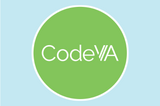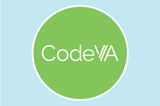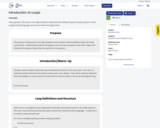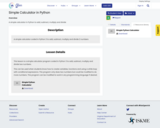
A simple Python program to determine if two words are anagrams
- Subject:
- Algorithms and Programming
- Computer Science
- Material Type:
- Activity/Lab
- Assessment
- Homework/Assignment
- Author:
- Ronald Sparks
- Date Added:
- 05/25/2022


A simple Python program to determine if two words are anagrams

This activity will allow students to compare Brute Force and Divide and Conquer sorting algorithms.This activity will show the sorting process of a Brute Force algorithm and a Divide and Conquer algorithm that is used by a computer when sorting data.

This activity will show the sorting process using the Bubble Sort Brute Force algorithm that is used by a computer when sorting data without using a computer.

These modules are designed to help you get familiar with Python while exploring interactive narrative design, where we put together stories that leave space for the reader to explore, make choices, and engage with the events of the story in a participatory way. Each module in this course follows the same format:Backstory: Unpack the context around the module, set up catalyzing questions to guide the inquiry throughout the module, and establish goals and objectives for your engagement with the moduleGuided Inquiry: Step through a sequence of tutorials and hands-on activities designed to help you learn the basic ideas presented in the modulesPrompt: A tightly-bounded, focused activity designed to facilitate sustained engagement with the ideas presented in the moduleCatalyzing Questions: A series of questions intended to provoke reflection & to put the module’s content in contextEach module is intended to support between 30 and 60 minutes of focused, sustained engagement. You may find it suits you to leave the module in the middle and return to your work; that’s totally fine. Work at your own pace, and don’t hesitate to reach out to your facilitators if you run into any problems.

In this extension, students will evaluate the role of data collection in their lives. They’ll identify some common data collection practices, evaluate the ethics of those practices, and develop a framework for thinking about when data collection is appropriate and when it is exploitative.

The purpose of this lesson is to help students understand the different types of loops present in their programming language and how to build and apply them.

This is an introduction to the concept of modulus. Students will compute various problems involving the modulus operator.

This is a lesson plan on iteration and looping to be used with high school aged students who are using the python programming language. This resource includes a PowerPoint presentation along with a python file for students to use to practice the concept of iteration. The python file has areas in which the student is asked to complete the statement by inserting variables in the program. As the student works through the steps of the program, the steps build up to the final task which is to write the code for a basic random number generator.

Students will be able to describe how “intelligence” differs between machines and humans.

Students will be able to describe computer hardware and choose appropriate components for users.

Explore the four main phases of the problem-solving process. Analyze a problem and use the steps in the problem-solving process to solve a problem.

This activity will show the sorting process using the Merge Sort Divide and Conquer algorithm that is used by a computer when sorting data without using a computer.

Want to introduce some basic coding and real life examples of the Scientific Method? This is the lesson for you. Using either the online program MakeCode, or by purchasing the Handheld Kitronik Arcades, the students will be performing an experiment while coding a maze game. No purchases required if students only use the online platform. A whole lesson ready to engage your students and use Computer Science and the Scientific Method!

Is AI more frightening than Frankenstein’s monster?

This lesson introduces 9-12 grade students to the Python random library. The program will choose a random number using functions from the Python random library in a set number range. The program will prompt the player to choose a number in the given range and keep track of the number of guesses the player makes. If the player guesses higher than the chosen number, it will give the player a message that their guess is too high. If the player guesses lower than the chosen number, it will give the player a message their guess is too low. The program will continue to prompt the player for guesses until they guess the correct number.

This activity will show the sorting process using the Quick Sort Divide and Conquer algorithm that is used by a computer when sorting data without using a computer.

Before goods are shipped in trucks or containers, they are usually placed in protective packaging and arranged on pallets for efficient transport. Stacking goods on a pallet is a repetitive job that can cause injury to workers. Because of this, many factories that require a high volume of palletization have turned to using robots to perform palletizing tasks. In this lesson plan, students learn how to program a robot to be efficient and effective at this real-world task.

Sensors are part of most modern day technologies. They are integrated into our vehicles, appliances, buildings, and phones. Touch sensors trigger doors to open, motion sensors detect moving vehicles or pedestrians, and heat sensors supply an extra level of safety to our stoves. Sensors are integral to how we interact with technology and are becoming more common in the systems around us.In this lesson, students will explore some of the sensors used in transportation. They will make their own touch sensor and program a sign to display a message or warning when their sensor is triggered.

A simple calculator in Python to add, subtract, multiply and divide

This lesson introduces 9-12 grade students to the tuple data type using Python. Students will learn what tuples are and how to create and use them.